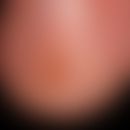Synonym(s)
Mulvihill-Smith Syndrome; Progeroid short stature with pigmented nevi
HistoryThis section has been translated automatically.
Mulvihill and Smith, 1975
Occurrence/EpidemiologyThis section has been translated automatically.
Prevalence: <1: 1. 000. 000
You might also be interested in
ManifestationThis section has been translated automatically.
Neonatal/infant age
ClinicThis section has been translated automatically.
Rare progeria syndrome (MIM: 176690) with autosomal-dominant inheritance, signs of premature aging ( progeria), short stature, acute facial shape (deficient formation of the subcutaneous fatty tissue of the face) and multiple melanocytic nevi. Patients with progeria minor growth pigment naevi syndrome continue to show signs of immunodeficiency with a tendency to infections, high voice and progressive loss of hearing and vision. Motor and intellectual development are usually normal or only slightly restricted. Remarkable are the missing hair in the armpits, sparse head hair with normal pubic hair. Other phenomena can be: hypodontia, microstomy, increased tendency to caries, diabetes mellitus.
Diet/life habitsThis section has been translated automatically.
LiteratureThis section has been translated automatically.
- Fühler-Stiller et al. (2011) Suspect pigment tumor in Mulvihill-Smith syndrome. SDDG 9: 308-311
- Mulvihill JJ Smith DW (1975) Another disorder with prenatal shortness of stature and premature aging. Birth Defects Orig Artic Ser 11: 368-370
Disclaimer
Please ask your physician for a reliable diagnosis. This website is only meant as a reference.




